There are many things to be aware of and consider as healthcare practitioners to ensure that we administer vaccinations to infants and children safely and efficiently. Being adequately prepared, allowing suitable distraction techniques and maintaining a comfortable secure positioning when vaccinating, all help to lessen not just fear and anxiety, but also pain too.
Pre vaccination advice
Before you administer vaccinations to infants and children, you should ensure that you are confident to provide information on what you are giving. Discussions should include information on the disease, potential adverse effects, and what to do if any reactions occur.

You should also explain the immunisation procedure to the parent/carer and what they will need to do to assist you in holding their child. Verbal informed consent should then be obtained prior to vaccinating.
Depending on the child’s age and maturity, it can be helpful to discuss the advantages of vaccination with them. Explaining how it can help to develop immunity in their body, allowing them to fight off infections and protect others around them, can all help to encourage and empower.
How to manage anxiety when you administer vaccinations to infants and children
Having a vaccination can be a very anxious time not just for young children but also for parents too. Many can feel worried, and measures should be taken to help manage any concerns or uncertainties that they may have.
Building up a rapport with the child is important. Ask them questions about what they are doing that day, what they enjoy, and what their favourite programme/movie/toy is! Be aware of your body language, and try to be relaxed and open. Smile, be friendly, try to make them laugh and make them feel as relaxed as possible.


It can help to break the process down into smaller steps and explain what you are doing as you go. This can help to ensure that they are not left feeling overwhelmed. Be open and honest, use appropriate language. It can help to explain it may feel like a pinch, poke or pressure when vaccinating. Give autonomy to the child, make them feel heard, and assure them that you understand their worries and concerns.
Most children won’t turn down a sticker! Get a supply in your clinic ready to show them what they will get if they are brave.
Checks before you administer vaccinations to infants and children
Before you give any vaccination it is important that you have followed the 5 R’s of medication administration. This includes checking that you have the right patient, the right medication, the right dose, the right route and the right time.
You should ensure that the child is healthy and not suffering from an acute febrile illness. You must also confirm that there are no contraindications to administering the vaccine. This includes a history of severe adverse reactions to either the immunisation or any of the components of the vaccine. If they are receiving live vaccinations, such as MMR, you must ensure that they are immunocompetent.

As an immuniser, you should be aware of your Patient Group Directions (PGD’s) and be confident with how to use them. You should also know who to contact to seek further guidance and support if any issues or concerns.
Identifying the correct site
The site that you will administer the vaccination will depend on the age and size of the child, the route used and the amount of vaccine given.

In infants under the age of 1 year old, the anterolateral aspect of the thigh muscle (vastus lateralis) is the recommended site for vaccinations. This is because it provides a large muscle mass to which you can safely administer the vaccine.
Figure 4.2 Source UK Health Security Agency (UKHSA) – Green Book Chapter 4: Immunisation procedures

Over 12 months of age, the recommended site is the deltoid.
Figure 4.1 UKHSA – Green Book Chapter 4: Immunisation procedures.
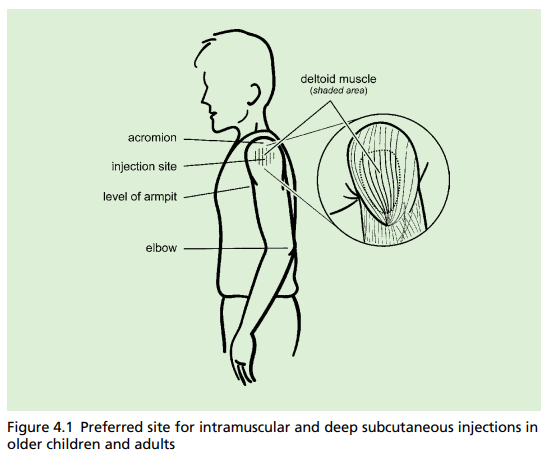
If you need to administer two or more vaccinations simultaneously, they should be administered at separate sites, ideally in different limbs. If this is not possible, then you should ensure that they are given at least 2.5 cm apart.
Choosing the right needle length
A 25mm 23G (blue) or 25mm 25G (orange) needle should be used for intramuscular injections in infants and children. According to research, 25mm needles produced equivalent immunogenicity and were linked with significantly fewer local adverse reactions than shorter needles.
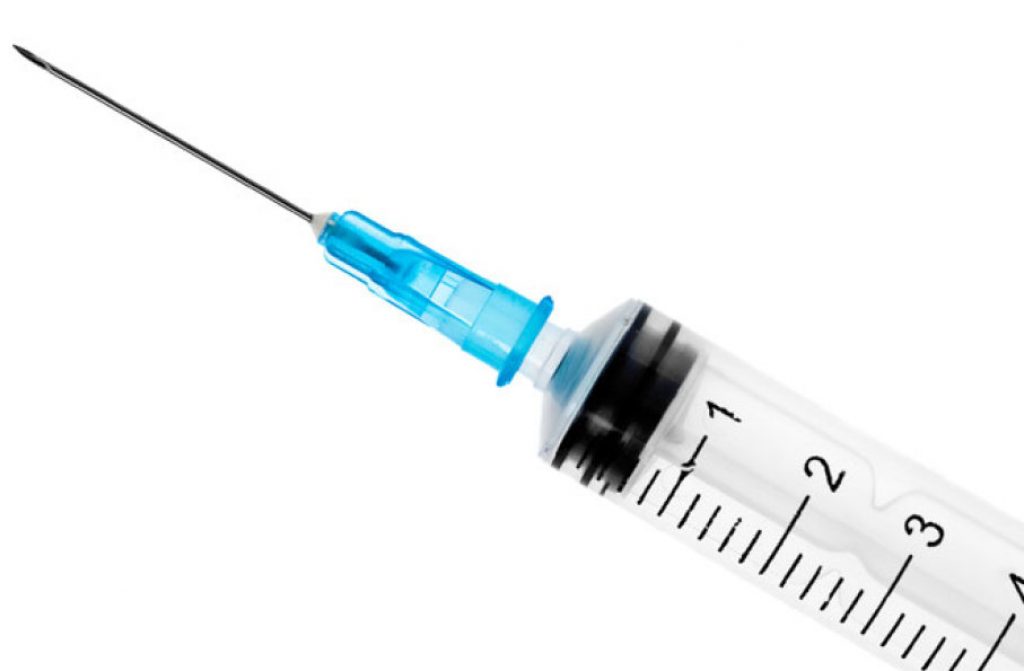
Only preterm or very small infants should receive vaccinations with the 16mm needle. Otherwise, there is a chance that the vaccine will accidentally be injected subcutaneously rather than intramuscularly.
Positioning of infants and children
In order to administer vaccinations to infants and children safely, it’s crucial to ensure the right positioning. Having their parent/carer assist with holding them still during the vaccination can ensure the child doesn’t move suddenly, reducing the risk of a needle stick injury or the vaccine not being administered properly.
Holding them can also help to provide comfort and ensure that they feel safe. It will allow you to have full control whilst vaccinating the child and ensure that you are able to have a clear view of the injection site which should be exposed so that you can accurately identify your anatomical markers by feel and sight.
The correct positioning of the infant and child when vaccinating depends on their age and size. The following are various methods that can be used depending on the age group:
Cuddle method
Using the cuddle position, the infant lies sideward on the parent or carer’s lap, cuddling into their chest. In this position they can hold the infant’s outside arm and outside leg in order to secure them.

The feet can be anchored between their thighs with the infant’s hip and knees slightly flexed to help to relax the vastus lateralis muscle.
This position can also be used when vaccinating older children. The child can sit sideways on the parent or carer’s lap whilst they hold their arm securely close to their body at the elbow.
Straddle method
In older children, they can also sit on the parent or carer’s lap with their arms folded in front, facing them in a straddle position. The parent/carer should then hug the child’s upper body and secure their arms.
Independent method
Older children may be able to sit independently on the clinic bench or on the parent or carer’s knee. If on their lap, they can help to hold them by anchoring their legs between their thighs and holding on to the child’s arms whilst you are vaccinating.

How to administer vaccinations to infants and children safely
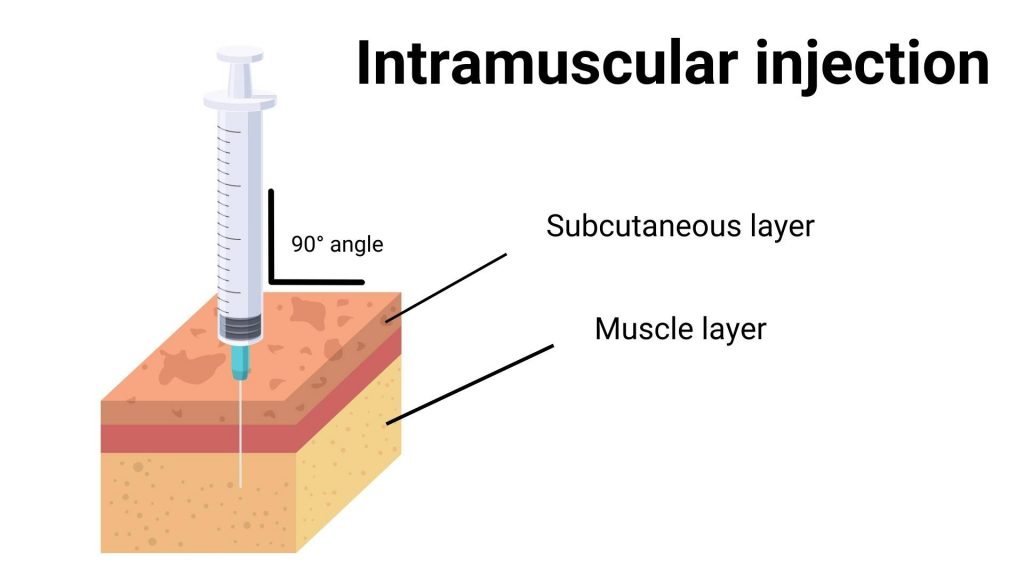
IM injections should be administered at a 90-degree angle with the skin stretched flat and not bunched.
If administering oral rotavirus alongside other routine immunisations, you should give this first. Research has shown that the sucrose content in the vaccine can help to reduce discomfort from vaccinations.
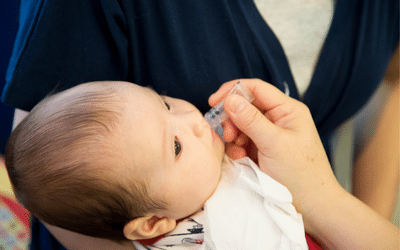
Distraction Techniques when you administer vaccinations to infants and children
Various techniques including distraction and relaxation have been shown to help young children cope with the stress and discomfort of vaccines.

Depending on the child’s age and maturity, some comforting and diverting tactics that may be used include reading, playing a game, listening to music, singing, or shaking a loud toy for very young children and babies.
You probably already know how difficult it can be to capture a little one’s attention when they are watching their favourite television programme on a screen! Using smartphones or tablets can also be another successful distraction technique.


Feeding can be promoted in infants during or shortly before vaccination. Skin-to-skin contact, comfort, the sweetness of the milk and the act of sucking may all aid to decrease discomfort experienced after immunisation.
To promote relaxation in children, taking deep breaths can help them feel calm and reduce their body’s reaction to discomfort. Blowing bubbles might also assist to calm and divert their breathing.
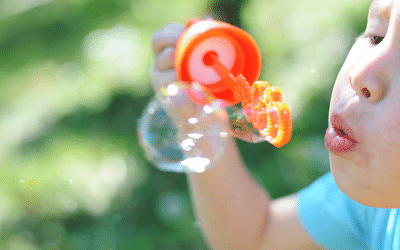
Some children may want to be more engaged in the immunisation process. If they are interested in playing doctors and nurses, take advantage of this! They may even assist in administering a pretend vaccine to their favourite toy to ensure they are protected. Their favourite toy could even receive a sticker and plaster too!
Post Vaccination advice
After immunisation, allow the infant or child to be soothed by their parent/carer. Give encouragement and comfort, as well as praise and stickers!
You should advise the parent or carer on what to do in the event of adverse effects. This includes who to call if they are worried and where to get further information. The patient information leaflet (PIL) should be supplied.

With the exception of Men B vaccine, paracetamol is not generally recommended to be given during or immediately after vaccination to reduce the risk of fever in infants and children. However, parents and caregivers should be reminded that if their child develops a fever, or is in pain after being vaccinated, they can provide paracetamol or ibuprofen.
Keep an eye out for any early signs of adverse effects. While anaphylaxis is extremely rare, it is important for anyone delivering immunisations to be aware of the signs and symptoms and what to do in the event of this occurring.
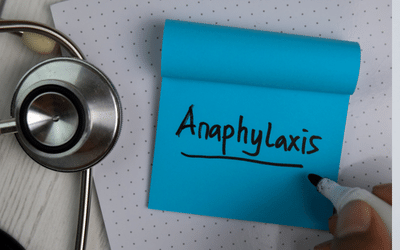
Any significant adverse event, such as anaphylaxis, generally manifests quickly, often within minutes. Using the time after vaccinating to complete the child’s red book and documentation allows you to keep watch to ensure they are feeling well and there are no immediate signs of a serious reaction.
In summary
Being prepared and having an understanding of how to help reduce discomfort, anxiety and pain that may come with immunisations can help to ensure you administer vaccinations to infants and children safely and effectively. Ultimately, this helps to enhance the child and the parent’s overall experience, improving compliance with attendance of future vaccination.
Want to learn more about vaccinating?
If you are new to vaccination the national immunisation training standards for both healthcare professionals and healthcare support workers provides guidelines on completing a foundation course in immunisation. Supervised practice is also recommended before you practice alone. Training should be updated on an annual basis.
Check out course options for both new vaccinators and those wanting an annual update.
UKHSA – Green Book Chapter 4: Immunisation Procedures https://www.gov.uk/government/publications/immunisation-procedures-the-green-book-chapter-4
CDC General Best Practice Guidelines for Immunization https://www.cdc.gov/vaccines/hcp/acip-recs/general-recs/administration.html
Australian Immunisation Handbook https://immunisationhandbook.health.gov.au/contents/vaccination-procedures/administration-of-vaccines



